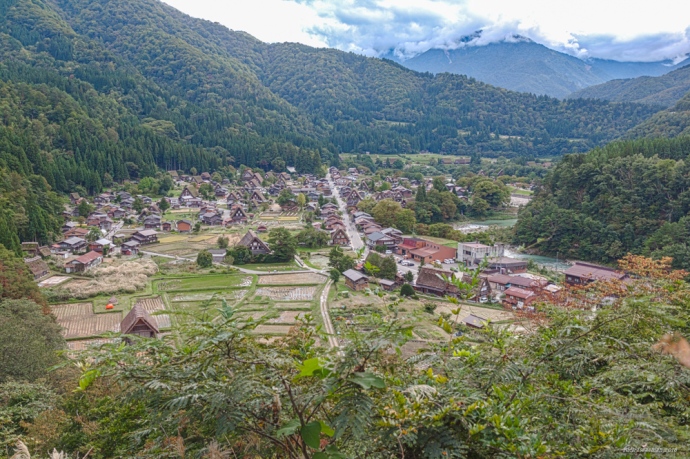You know, there probably ought to be an island somewhere where all the people who have vanishing, obsolete, or traditional but obscure skill sets can all live together in peace and harmony. You know: geishas, blacksmiths, slide rule designers, coopers (when’s the last time you had a barrel made?), roof thatchers, that sort of thing. If such a place existed, you can bet that a disproportionate segment of the population would be Japanese. We saw a bunch of them today.
Today’s destinations were all in the UNESCO World Heritage locales of Gokayama and Shirakawa-go and a few of the neighboring towns. They are characterized by a number of attributes: stunning valley settings, gassho farmhouse architecture (which I’ll explain in a moment), and the preservation of what to our philistine Western sensibilities are obscure but colorful arts and crafts. Let’s start with the settings and the architecture.
“Gokayama” means “five mountains”. (Remember that -yama is a suffix meaning “mountain”, as in Fujiyama.) This part of the country is mountainous, which means two things: striking vistas and a lot of snow in winter. Our first stop was the village of Ainokura, a settlement of 1000 people or so nestled in a Shangri-la-like valley (I wish there were some way of typing that without two hyphens) ringed by cloud-misted green peaks. The building roofs are all thatched — very thick thatching, perhaps two feet through, mounted on a steep A-frame with about a 60-degree cant to prevent snow accumulation. And that, gentle reader, is more or less the definition of gassho architecture. The word itself means “praying hands”, which more or less describes the shape of the roof. There are a couple of things to pray for, e.g., that the village won’t get six feet of snow again this winter, because, tradition or no tradition the locals are sick of shoveling the stuff. The residents might also pray that no moronic tourist lights up a cigarette, since a wood frame house with a thatched roof is a conflagration waiting to happen. All of the houses in Ainokura are like this, giving it the feel of a 16th century Colonial Williamsburg. (And the brochures and signs do indeed ask you not to smoke.) We enjoyed a woodcut-worthy photogenic overlook of the town, and ambled around the streets for a while.
Our next stop was the village of Taira, where they, um, pound rice. Not quite sure how else to describe it, really. The desired end product is mochi, or Japanese rice cake. “Cake” hardly seems like the right word, though: mochi is a essentially a little ball of rice gluten, which you can flavor by rolling it in a little sugar and soy powder or dipping it in soy. It’s gummy, sort of like an edible ball of doughy Silly Putty, though gooier and much easier to chew. It’s considered a special treat because making it in the proper fashion is labor-intensive: one person repeatedly pounds a bucket full of rice with a wooden sledgehammer while a second reaches into the goo between hammer strokes to add a bit of water and do a very quick knead. Time it wrong and the second person is looking at five broken fingers. (I asked Mariko how often this occurs among practitioners; she translated the question and was informed that it never happens. However that is only because I don’t attempt to make mochi; otherwise the local hospital would have to hire a new full-time doctor just to apply splints.)
Like everything else in Japan, mochi is steeped in tradition. You can’t just whale away with your Sears Craftsman hammer into a bowl of Uncle Ben’s Rice. You need just the right kind of rice, soaked for the right amount of time, pounded with the right wooden sledgehammer, and so forth. It’s all very traditional and precise, though the end product is very enjoyable. (At least for me; Alice was not so crazy about it.)
This ethos of doing things just so, using the ancient ways, is certainly a core part of Japanese tradition. We saw it again a few minutes later just down the road, where we made “Gokayama Mashi” paper. Or so they told us; would be more accurate to say that we participated in the final two steps (out of about 20) of making the much-prized, high-fiber paper. A traditional plant must be harvested, and the wrong kind of fibers removed, then boiled, and have other stuff added to it, then this, then that, then something else, and if I remember the informational video correctly then about two months later you have a sheet of very nice paper indeed, which you damn well better use for something important.
Our role in the process was to repeatedly dip a small screen about the size of a dinner tray into a trough of white liquid fibrous pulp, rather like rice pudding. You dip the screen into the pulp in a scooping motion to avoid trapping air bubbles, then lift it out and hold it horizontally to let the water drain. Repeat two more times. Decorate with colorful cutout bits of paper: cats, moons, fish. Hand the screen to a guy who carefully peels out the wet paper-to-be and sticks it flat against a hot drying surface, which is just a vertical panel of heated sheet metal. Twenty minutes later you have a sheet of paper with your decorations embedded in it.
We moved on to a traditional lunch (do you sense a pattern emerging?), “tradition” in this case being an unusual vegetarian lunch of what of what are called “mountain vegetables”, which included items like fiddlehead fern. It was interesting, not at all bad, and a source of nostalgia for Mariko, who remembers her grandmother going into the mountains to gather vegetables for such a meal. Now it’s uncommon; it is hard to find the ingredients in a supermarket, and they are quite expensive.
Lunch concluded with a musical interlude. Two of the ladies who staffed the restaurant did a simple traditional dance while playing the binzasara, a bizarre percussion instrument that is basically a row of clappers strung tightly together. You hold the two ends and snap your wrist, which causes a wave to propagate down the row of clappers, like tightly-spaced dominoes falling. It makes a clattery buzzing sound, indeed rather like what you’d get if you recorded a bunch of falling dominoes and then played back the audio at high speed. We all tried it; it’s a little tricky but you get the hang of it quickly. The instrument is a big deal around here: as you drive into this village of Taira, you pass under an archway shaped like one.
I am happy to report that we were able to answer this particular Japanese musical tradition with an American musical tradition. Joe, one of our travel group, is a “sonic afficionado”, if there is such a term, who delights in whistling, making sound effects, and generally utilizing whatever is at hand (e.g., a blades of grass) to make noise. He travels with a pocket harmonica at all times — a practice that I recommend on philosophical grounds — and so responded to the binzasara performance by standing up and playing a long, impressive blues piece on his harmonica. It was quite a performance and he brought down the house. (I had told him earlier that I was planning on sending him a USB stick with all my photos; he said that in return he would send me one of his harmonica instructional videos. Seems like a very fair trade.)
We had two more stops to make after lunch, but i will be brief since it is getting late and this post is already somewhat longer than average. The first was the 500-year old home of the Iwase family, who have occupied it for 18 generations. The house dates back to the samurai era and has variously been used to store gunpowder, silk, and other commodities. I’m not sure if it is technically in the gassho style since the roof is not as steeply tilted as the other buildings. But the thatching was thick and robustly bound to heavy circular beams on the upper floors. Now the is just a family home, but the Iwases use it to (you guessed it) keep some of the old traditions alive, notably the kokiriko dance.
Kokiriko is the oldest traditional Japanese dance, accompanied by a binzasara and percussion sticks. Though performed by women now, it was originally a dance performed only by the nobles and was used to celebrate the hunt. The costumes are said to be silk versions of a hunting outfit; I infer that the role of the hat (see photo above!) was to facilitate the hunt by making the animals convulse with derisive laughter. (“Look at that stupid hat! You can’t even see anyth…OUCH ARROWS! OUCHouchouchouch…”) The Iwases served us tea after the dance, and we explored the house for a while.
Our final stop of the day was Shirakawa-go itself, essentially a larger and more touristy version of the village of Ainokura that we saw first thing this morning. Like Ainokura, it sits serenely yet strikingly in a valley dotted with rice paddies and ringed with mountains. We admired the view, walked down into the town, then headed back to Kanazawa for a decidedly non-traditional Japanese dinner: Chinese food



 .Thus concludes our stay in Kanazawa. Tomorrow we head off to Kyoto for five nights, the final leg of our trip.
.Thus concludes our stay in Kanazawa. Tomorrow we head off to Kyoto for five nights, the final leg of our trip.










Very interesting post and stunning photos. I’ve never heard of any of this.